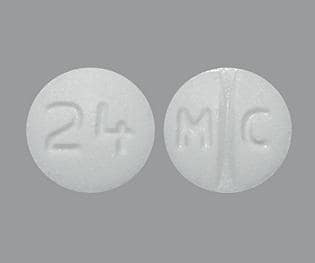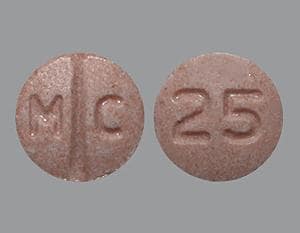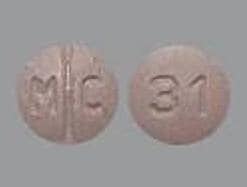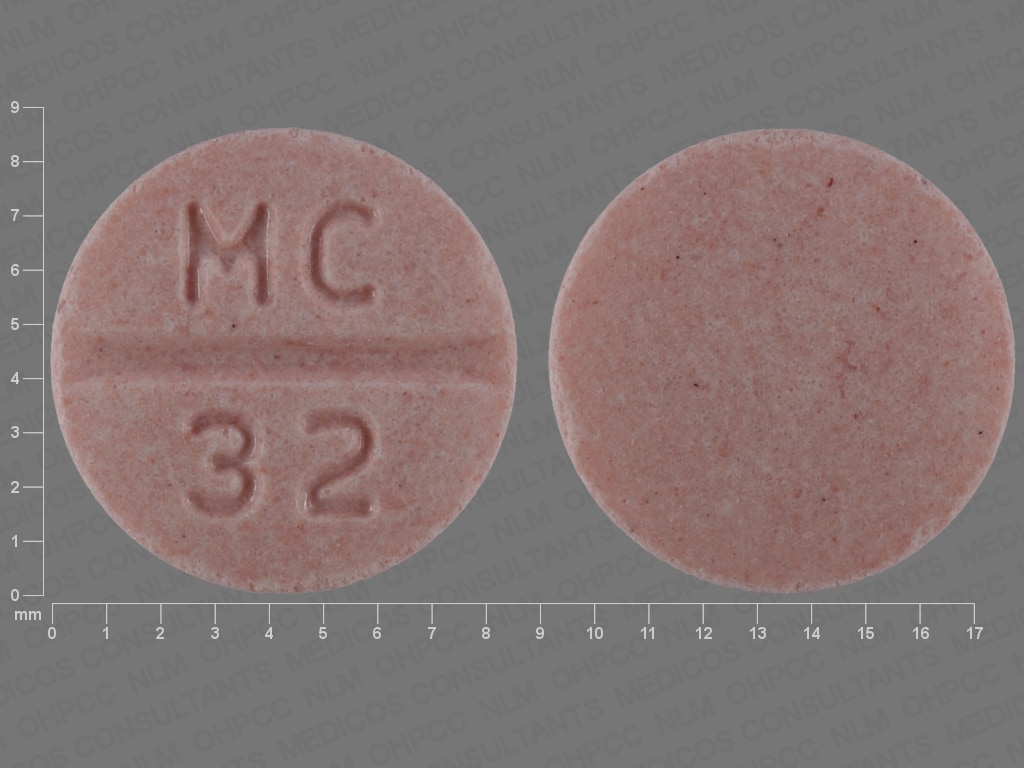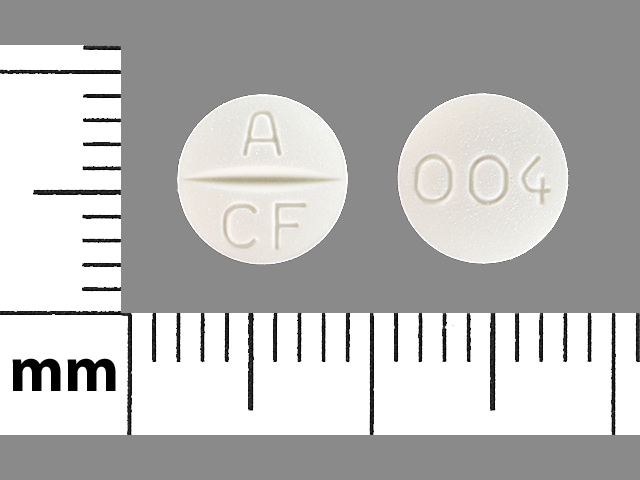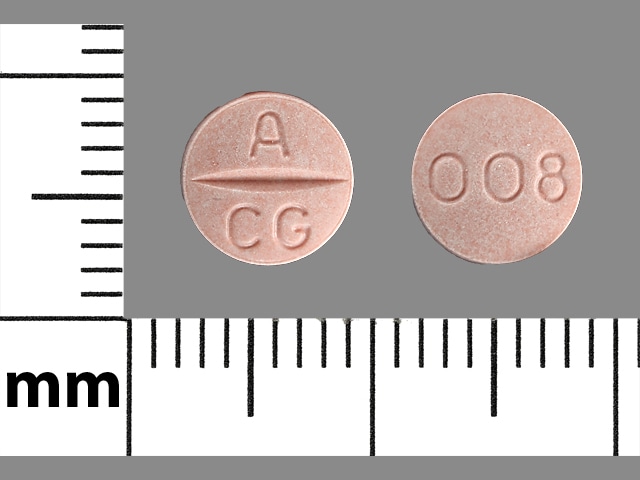Boxed Warning
Fetal toxicity:
When pregnancy is detected, discontinue candesartan as soon as possible. Drugs that act directly on the renin-angiotensin system can cause injury and even death to the developing fetus.
Dosage Forms
Excipient information presented when available (limited, particularly for generics); consult specific product labeling. [DSC] = Discontinued product
Tablet, Oral, as cilexetil:
Atacand: 4 mg [DSC] [scored]
Atacand: 4 mg [scored; contains corn starch]
Atacand: 8 mg [DSC] [scored]
Atacand: 8 mg [scored; contains corn starch]
Atacand: 16 mg [DSC] [scored]
Atacand: 16 mg [scored; contains corn starch]
Atacand: 32 mg [DSC] [scored]
Atacand: 32 mg [scored; contains corn starch]
Generic: 4 mg, 8 mg, 16 mg, 32 mg
Pharmacology
Mechanism of Action
Candesartan is an angiotensin receptor antagonist. Angiotensin II acts as a vasoconstrictor. In addition to causing direct vasoconstriction, angiotensin II also stimulates the release of aldosterone. Once aldosterone is released, sodium as well as water are reabsorbed. The end result is an elevation in blood pressure. Candesartan binds to the AT1 angiotensin II receptor. This binding prevents angiotensin II from binding to the receptor thereby blocking the vasoconstriction and the aldosterone secreting effects of angiotensin II.
Pharmacokinetics/Pharmacodynamics
Absorption
Candesartan: Rapid and complete following conversion from candesartan cilexetil by GI esterases
Distribution
Vd: 0.13 L/kg
Metabolism
Converted to active candesartan, via ester hydrolysis during absorption from GI tract; hepatic (minor) via O-deethylation to inactive metabolite
Excretion
Feces (67%); urine (33%; 26% as unchanged drug)
Clearance: Total body: 0.37 mL/minute/kg; Renal: 0.19 mL/minute/kg; decreased with severe renal impairment
Onset of Action
2 to 3 hours; antihypertensive effect: Within 2 weeks
Peak effect: 6 to 8 hours; maximum antihypertensive effect: 4 to 6 weeks
Time to Peak
Children (1 to 17 years); Adults: 3 to 4 hours
Duration of Action
>24 hours
Half-Life Elimination
Dose dependent: 5 to 9 hours
Protein Binding
>99%
Use in Specific Populations
Special Populations: Renal Function Impairment
In hypertensive patients with CrCl <30 mL/minute/1.73 m2, the AUC and Cmax are approximately doubled. In heart failure patients with renal impairment, AUC is 36% and 65% higher and Cmax is 15% and 55% higher in patients with mild and moderate renal impairment, respectively.
Special Populations: Hepatic Function Impairment
The AUC and Cmax increased 30% and 56% in mild impairment and 145% and 73% in moderate impairment, respectively.
Special Populations: Elderly
Cmax is ~50% higher; AUC is ~80% higher.
Use: Labeled Indications
Heart failure with reduced ejection fraction: Treatment of heart failure (NYHA class II to IV) in adults with left ventricular systolic dysfunction (ejection fraction <40%) to reduce cardiovascular death and heart failure hospitalization.
Hypertension: Management of hypertension in adults and children ≥1 year of age.
Use: Off Label
Non-ST-elevation acute coronary syndromeyes
Based on the 2014 American Heart Association/American College of Cardiology (AHA/ACC) guidelines for the management of patients with non-ST-elevation acute coronary syndromes, an angiotensin II receptor blocker (ARB) is recommended and effective in patients who have indications for but are intolerant of angiotensin-converting enzyme (ACE) inhibitors; this includes patients with hypertension, diabetes, stable chronic kidney disease (CKD), heart failure, or myocardial infarction who have a left ventricular ejection fraction ≤40%.
Proteinuric chronic kidney disease (diabetic or nondiabetic)yes
Based on the 2012 Kidney Disease Improving Global Outcomes guidelines, the use of an ACE inhibitor or an ARB is recommended in patients with proteinuric CKD to prevent progression of CKD.
ST-elevation myocardial infarctionyes
Based on the 2013 ACC/AHA guidelines for the management of patients with ST-elevation acute coronary syndromes, an ARB is recommended and effective in patients who have indications for but are intolerant of ACE inhibitors.
Contraindications
Hypersensitivity to candesartan or any component of the formulation; concomitant use with aliskiren in patients with diabetes mellitus
Documentation of allergenic cross-reactivity for angiotensin II receptor blockers is limited. However, because of similarities in chemical structure and/or pharmacologic actions, the possibility of cross-sensitivity cannot be ruled out with certainty.
Canadian labeling: Additional contraindications (not in US labeling): Concomitant use with aliskiren in patients with moderate-to-severe renal impairment (GFR <60 mL/minute/1.73 m2); pregnancy; breastfeeding; children <1 year of age; rare hereditary problems of galactose intolerance, Lapp lactase deficiency or glucose-galactose malabsorption
Dosage and Administration
Dosing: Adult
Acute coronary syndromes: Note: May be used as an alternative in patients who cannot tolerate an angiotensin-converting enzyme (ACE) inhibitor (eg, due to cough) (ACC/AHA [Amsterdam 2014; O'Gara 2013]; Guyer 2019). In patients with prior ACE inhibitor-associated angioedema (ie, without urticaria or other signs of hypersensitivity), an angiotensin II receptor blocker (ARB) may also be an alternative. ARBs do not appear to elevate the risk of angioedema (Rasmussen 2019; Toh 2012); however, patients must be educated that angioedema due to an ACE inhibitor can sometimes reoccur within months following discontinuation (Beltrami 2011); referral to an allergist may be appropriate.
Non-ST-elevation acute coronary syndrome (alternative agent) (off-label use): Note: Patients should be hemodynamically stable before initiation. Use as a component of an appropriate medical regimen, which may also include antiplatelet agent(s), a beta-blocker, and a statin. Continue ARB therapy indefinitely for patients with concurrent diabetes, left ventricular ejection fraction ≤40%, hypertension, or stable chronic kidney disease (CKD) (AHA/ACC [Amsterdam 2014]). Dosing is based on general dosing range in the manufacturer's labeling.
Oral: Initial: 8 mg once daily; increase dose as tolerated up to 32 mg/day under close monitoring to avoid hypotension.
ST-elevation myocardial infarction (alternative agent) (off-label use): Note: Patients should be hemodynamically stable before initiation. Use as a component of an appropriate medical regimen, which may also include antiplatelet agent(s), a beta-blocker, and a statin. Continue ARB therapy indefinitely (ACC/AHA [O'Gara 2013]). Dosing is based on general dosing range in the manufacturer's labeling.
Oral: Initial: 8 mg once daily; increase dose as tolerated up to 32 mg/day under close monitoring to avoid hypotension.
Heart failure with reduced ejection fraction: Note: May be used as an alternative in patients who cannot tolerate an ACE inhibitor (eg, due to cough) (ACC/AHA/HFSA [Yancy 2017]; Guyer 2019). In patients with prior ACE inhibitor- or angiotensin receptor-/neprilysin inhibitor-associated angioedema (ie, without urticaria or other signs of hypersensitivity), candesartan may be an alternative (Meyer 2019); however, use in this situation should only occur under the care of a heart failure specialist. ARBs do not appear to elevate the risk of angioedema (Rasmussen 2019; Toh 2012); however, patients must be educated that angioedema due to an ACE inhibitor can sometimes reoccur within months following discontinuation (Beltrami 2011); referral to an allergist may be appropriate.
Oral: Initial: 4 to 8 mg once daily; increase the dose every 2 weeks based on response and tolerability; target dose: 32 mg once daily (ACC/AHA [Yancy 2017]; Meyer 2019).
Hypertension: Note: For initial treatment in patients with blood pressure ≥20/10 mm Hg above goal, may be used in combination with another appropriate agent (eg, long-acting dihydropyridine calcium channel blocker, thiazide diuretic). For patients <20/10 mm Hg above goal, some experts recommend an initial trial of monotherapy; however, over time, many patients will require combination therapy (ACC/AHA [Whelton 2018]; Mann 2019a).
Oral: Initial: 8 mg once daily; evaluate response every 4 to 6 weeks and increase dose as needed up to 32 mg once daily (ACC/AHA [Whelton 2018]; Mann 2019a).
Proteinuric chronic kidney disease (diabetic or nondiabetic) (off-label use): Note: In nondiabetic and type 2 diabetic proteinuric CKD, an ARB or an ACE inhibitor may be used. In type 1 diabetic proteinuric CKD, an ARB may be used as an alternative in patients who cannot tolerate an ACE inhibitor (eg, due to cough) (Bakris 2019; Mann 2019b, McCulloch 2019). In patients with prior ACE inhibitor-associated angioedema (ie, without urticaria or other signs of hypersensitivity), candesartan may be an alternative. ARBs do not appear to elevate the risk of angioedema (Rasmussen 2019; Toh 2012); however, patients must be educated that angioedema due to an ACE inhibitor can sometimes reoccur within months following discontinuation (Beltrami 2011); referral to an allergist may be appropriate. Dosing is based on general dosing range in the manufacturer's labeling.
Oral: Initial: 8 mg once daily; can be increased to 32 mg once daily based on blood pressure response and tolerability. Target to an appropriate blood pressure goal and a proteinuria goal of <1 g/day (KDIGO 2013; Mann 2019b).
IgA nephropathy: In addition to an appropriate blood pressure goal, a proteinuria goal of <1 g/day is also generally recommended (KDIGO 2012). Some experts treat to a proteinuria goal of <500 mg/day. If proteinuria goal is not met with monotherapy at the maximum dose, consider adding other modalities and/or agents (Cattran 2019).
Dosing: Geriatric
Refer to adult dosing.
Dosing: Pediatric
Note: Use of a lower initial dose is recommended in volume- and salt-depleted patients; if possible, correct volume depletion prior to administration; dosage must be individualized
Hypertension:
Children 1 to <6 years: Oral: Initial: 0.2 mg/kg/day once daily; titrate to response (within 2 weeks, antihypertensive effect usually observed); usual range: 0.05 to 0.4 mg/kg/day divided once or twice daily; maximum daily dose: 0.4 mg/kg/day; higher doses have not been studied.
Children and Adolescents 6 to <17 years: Oral:
<50 kg: Initial: 4 to 8 mg/day once daily; titrate to response (within 2 weeks, antihypertensive effect usually observed); usual range: 2 to 16 mg/day divided once or twice daily; maximum daily dose: 32 mg/day; higher doses have not been studied.
>50 kg: Initial: 8 to 16 mg/day once daily; titrate to response (within 2 weeks, antihypertensive effect usually observed); usual range: 4 to 32 mg/day divided once or twice daily; maximum daily dose: 32 mg/day; higher doses have not been studied.
Adolescents ≥17 years: Oral: Initial: 16 mg once daily; titrate to response (within 2 weeks, antihypertensive effect usually observed; maximum effect seen within 4 to 6 weeks); usual range: 8 to 32 mg/day divided once or twice daily; blood pressure response is dose-related over the range of 2 to 32 mg; larger doses do not appear to have a greater effect and there is relatively little experience with such doses
Extemporaneously Prepared
Oral suspension may be made in concentrations ranging from 0.1 to 2 mg/mL; typically 1 mg/mL oral suspension suitable for majority of prescribed doses; any strength tablet may be used. A 1 mg/mL (total volume: 160 mL) oral suspension may be made with tablets and a 1:1 mixture of Ora-Plus® and Ora-Sweet SF®. Prepare the vehicle by adding 80 mL of Ora-Plus® and 80 mL of Ora-Sweet SF® or, alternatively, use 160 mL of Ora-Blend SF®. Add a small amount of vehicle to five 32 mg tablets and grind into a smooth paste using a mortar and pestle. Transfer the paste to a calibrated amber PET bottle, rinse the mortar and pestle clean using the vehicle, add this to the bottle, and then add a quantity of vehicle sufficient to make 160 mL. The suspension is stable at room temperature for 100 days unopened or 30 days after the first opening; do not freeze; label “shake well before use.” (Atacand prescribing information, 2013).
Administration
Oral: Administer without regard to meals. An oral suspension may be prepared for children unable to swallow tablets (refer to Extemporaneously Prepared information).
Storage
Store at 25°C (77°F); excursions permitted to 15°C to 30°C (59°F to 86°F).
Candesartan Images
Drug Interactions
Alfuzosin: May enhance the hypotensive effect of Blood Pressure Lowering Agents. Monitor therapy
Aliskiren: May enhance the hyperkalemic effect of Angiotensin II Receptor Blockers. Aliskiren may enhance the hypotensive effect of Angiotensin II Receptor Blockers. Aliskiren may enhance the nephrotoxic effect of Angiotensin II Receptor Blockers. Management: Aliskiren use with ACEIs or ARBs in patients with diabetes is contraindicated. Combined use in other patients should be avoided, particularly when CrCl is less than 60 mL/min. If combined, monitor potassium, creatinine, and blood pressure closely. Consider therapy modification
Amifostine: Blood Pressure Lowering Agents may enhance the hypotensive effect of Amifostine. Management: When amifostine is used at chemotherapy doses, blood pressure lowering medications should be withheld for 24 hours prior to amifostine administration. If blood pressure lowering therapy cannot be withheld, amifostine should not be administered. Consider therapy modification
Amphetamines: May diminish the antihypertensive effect of Antihypertensive Agents. Monitor therapy
Angiotensin II: Receptor Blockers may diminish the therapeutic effect of Angiotensin II. Monitor therapy
Angiotensin-Converting Enzyme Inhibitors: Angiotensin II Receptor Blockers may enhance the adverse/toxic effect of Angiotensin-Converting Enzyme Inhibitors. Angiotensin II Receptor Blockers may increase the serum concentration of Angiotensin-Converting Enzyme Inhibitors. Management: In US labeling, use of telmisartan and ramipril is not recommended. It is not clear if any other combination of an ACE inhibitor and an ARB would be any safer. Consider alternatives to the combination when possible. Consider therapy modification
Antihepaciviral Combination Products: May increase the serum concentration of Candesartan. Management: Per antihepaciviral combination product US prescribing information, consider decreasing the candesartan dose and monitoring for evidence of hypotension and worsening renal function if these agents are used in combination. Consider therapy modification
Antipsychotic Agents (Second Generation [Atypical]): Blood Pressure Lowering Agents may enhance the hypotensive effect of Antipsychotic Agents (Second Generation [Atypical]). Monitor therapy
Barbiturates: May enhance the hypotensive effect of Blood Pressure Lowering Agents. Monitor therapy
Benperidol: May enhance the hypotensive effect of Blood Pressure Lowering Agents. Monitor therapy
Brigatinib: May diminish the antihypertensive effect of Antihypertensive Agents. Brigatinib may enhance the bradycardic effect of Antihypertensive Agents. Monitor therapy
Brimonidine (Topical): May enhance the hypotensive effect of Blood Pressure Lowering Agents. Monitor therapy
Bromperidol: Blood Pressure Lowering Agents may enhance the hypotensive effect of Bromperidol. Bromperidol may diminish the hypotensive effect of Blood Pressure Lowering Agents. Avoid combination
CycloSPORINE (Systemic): Angiotensin II Receptor Blockers may enhance the hyperkalemic effect of CycloSPORINE (Systemic). Monitor therapy
Dapoxetine: May enhance the orthostatic hypotensive effect of Angiotensin II Receptor Blockers. Monitor therapy
Dexmethylphenidate: May diminish the therapeutic effect of Antihypertensive Agents. Monitor therapy
Diazoxide: May enhance the hypotensive effect of Blood Pressure Lowering Agents. Monitor therapy
Drospirenone: Angiotensin II Receptor Blockers may enhance the hyperkalemic effect of Drospirenone. Monitor therapy
DULoxetine: Blood Pressure Lowering Agents may enhance the hypotensive effect of DULoxetine. Monitor therapy
Eplerenone: May enhance the hyperkalemic effect of Angiotensin II Receptor Blockers. Monitor therapy
Heparin: May enhance the hyperkalemic effect of Angiotensin II Receptor Blockers. Monitor therapy
Heparins (Low Molecular Weight): May enhance the hyperkalemic effect of Angiotensin II Receptor Blockers. Monitor therapy
Herbs (Hypertensive Properties): May diminish the antihypertensive effect of Antihypertensive Agents. Monitor therapy
Herbs (Hypotensive Properties): May enhance the hypotensive effect of Blood Pressure Lowering Agents. Monitor therapy
Hypotension-Associated Agents: Blood Pressure Lowering Agents may enhance the hypotensive effect of Hypotension-Associated Agents. Monitor therapy
Levodopa-Containing Products: Blood Pressure Lowering Agents may enhance the hypotensive effect of Levodopa-Containing Products. Monitor therapy
Lithium: Angiotensin II Receptor Blockers may increase the serum concentration of Lithium. Management: Lithium dosage reductions will likely be needed following the addition of an angiotensin II receptor antagonist. Consider therapy modification
Lormetazepam: May enhance the hypotensive effect of Blood Pressure Lowering Agents. Monitor therapy
Methylphenidate: May diminish the antihypertensive effect of Antihypertensive Agents. Monitor therapy
Molsidomine: May enhance the hypotensive effect of Blood Pressure Lowering Agents. Monitor therapy
Naftopidil: May enhance the hypotensive effect of Blood Pressure Lowering Agents. Monitor therapy
Nicergoline: May enhance the hypotensive effect of Blood Pressure Lowering Agents. Monitor therapy
Nicorandil: May enhance the hyperkalemic effect of Angiotensin II Receptor Blockers. Monitor therapy
Nicorandil: May enhance the hypotensive effect of Blood Pressure Lowering Agents. Monitor therapy
Nitroprusside: Blood Pressure Lowering Agents may enhance the hypotensive effect of Nitroprusside. Monitor therapy
Nonsteroidal Anti-Inflammatory Agents: Angiotensin II Receptor Blockers may enhance the adverse/toxic effect of Nonsteroidal Anti-Inflammatory Agents. Specifically, the combination may result in a significant decrease in renal function. Nonsteroidal Anti-Inflammatory Agents may diminish the therapeutic effect of Angiotensin II Receptor Blockers. The combination of these two agents may also significantly decrease glomerular filtration and renal function. Monitor therapy
Obinutuzumab: May enhance the hypotensive effect of Blood Pressure Lowering Agents. Management: Consider temporarily withholding blood pressure lowering medications beginning 12 hours prior to obinutuzumab infusion and continuing until 1 hour after the end of the infusion. Consider therapy modification
Pentoxifylline: May enhance the hypotensive effect of Blood Pressure Lowering Agents. Monitor therapy
Pholcodine: Blood Pressure Lowering Agents may enhance the hypotensive effect of Pholcodine. Monitor therapy
Phosphodiesterase 5 Inhibitors: May enhance the hypotensive effect of Blood Pressure Lowering Agents. Monitor therapy
Potassium Salts: May enhance the hyperkalemic effect of Angiotensin II Receptor Blockers. Monitor therapy
Potassium-Sparing Diuretics: Angiotensin II Receptor Blockers may enhance the hyperkalemic effect of Potassium-Sparing Diuretics. Monitor therapy
Prostacyclin Analogues: May enhance the hypotensive effect of Blood Pressure Lowering Agents. Monitor therapy
Quinagolide: May enhance the hypotensive effect of Blood Pressure Lowering Agents. Monitor therapy
Ranolazine: May enhance the adverse/toxic effect of Angiotensin II Receptor Blockers. Monitor therapy
Sodium Phosphates: Angiotensin II Receptor Blockers may enhance the nephrotoxic effect of Sodium Phosphates. Specifically, the risk of acute phosphate nephropathy may be enhanced. Management: Consider avoiding this combination by temporarily suspending treatment with ARBs, or seeking alternatives to oral sodium phosphate bowel preparation. If the combination cannot be avoided, maintain adequate hydration and monitor renal function closely. Consider therapy modification
Tacrolimus (Systemic): Angiotensin II Receptor Blockers may enhance the hyperkalemic effect of Tacrolimus (Systemic). Monitor therapy
Tolvaptan: May enhance the hyperkalemic effect of Angiotensin II Receptor Blockers. Monitor therapy
Trimethoprim: May enhance the hyperkalemic effect of Angiotensin II Receptor Blockers. Monitor therapy
Yohimbine: May diminish the antihypertensive effect of Antihypertensive Agents. Monitor therapy
Test Interactions
May lead to false-negative aldosterone/renin ratio (ARR) (Funder 2016).
Adverse Reactions
>10%:
Cardiovascular: Hypotension (19%)
Renal: Renal function abnormality (13%)
1% to 10%:
Central nervous system: Dizziness (4%)
Endocrine & metabolic: Hyperkalemia (6%)
Neuromuscular & skeletal: Back pain (3%)
Respiratory: Upper respiratory tract infection (6%), pharyngitis (2%), rhinitis (2%)
Frequency not defined:
Central nervous system: Headache
Renal: Exacerbation of renal disease (children & adolescents), increased serum creatinine
<1%, postmarketing, and/or case reports: Abnormal hepatic function tests, agranulocytosis, angioedema, cough, hepatitis, hyponatremia, leukopenia, neutropenia, pruritus, skin rash, urticaria
Warnings/Precautions
Concerns related to adverse effects:
- Angioedema: Angiotensin II receptor antagonists (ARBs) do not appear to elevate the risk of angioedema (Rasmussen 2019; Toh 2012). Patients with a history of angioedema due to an angiotensin-converting enzyme (ACE) inhibitor must be educated that sometimes there can be recurrence within months following discontinuation (Beltrami 2011). No matter the cause of angioedema, prolonged frequent monitoring is required, especially if tongue, glottis, or larynx are involved, as they are associated with airway obstruction. Discontinue therapy immediately if angioedema occurs. Aggressive early management is critical. IM administration of epinephrine may be necessary. Do not readminister the ARB to patients who experience angioedema from this medication.
- Hyperkalemia: May occur; risk factors include renal dysfunction, diabetes mellitus, concomitant use of potassium-sparing diuretics, potassium supplements and/or potassium containing salts. Use cautiously, if at all, with these agents and monitor potassium closely.
- Hypotension: Symptomatic hypotension may occur upon initiation in patients who are salt- or volume-depleted (eg, those treated with high-dose diuretics). Consider lower initial dosages in volume depleted patients; if possible, correct volume depletion prior to administration. This transient hypotensive response is not a contraindication to further treatment with candesartan.
- Renal function deterioration: May be associated with deterioration of renal function and/or increases in serum creatinine, particularly in patients with low renal blood flow (eg, renal artery stenosis, heart failure) whose GFR is dependent on efferent arteriolar vasoconstriction by angiotensin II; deterioration may result in oliguria, acute renal failure, and progressive azotemia. Small increases in serum creatinine may occur following initiation; consider discontinuation only in patients with progressive and/or significant deterioration in renal function.
Disease-related concerns:
- Aortic/mitral stenosis: Use caution in patients with significant aortic/mitral stenosis.
- Ascites: Avoid use in patients with ascites due to cirrhosis or refractory ascites; if use cannot be avoided in patients with ascites due to cirrhosis, monitor blood pressure and renal function carefully to avoid rapid development of renal failure (AASLD [Runyon 2012]).
- Heart failure: Use caution when initiating in heart failure; may need to adjust dose, and/or concurrent diuretic therapy, because of candesartan-induced hypotension.
- Hepatic impairment: Systemic exposure increases in hepatic impairment. US manufacturer labeling recommends a dosage adjustment in patients with moderate hepatic impairment. Pharmacokinetics have not been studied in severe hepatic impairment.
- Renal artery stenosis: Use candesartan with caution in patients with unstented unilateral/bilateral renal artery stenosis. When unstented bilateral renal artery stenosis is present, use is generally avoided due to the elevated risk of deterioration in renal function unless possible benefits outweigh risks.
- Renal impairment: Use with caution with preexisting renal insufficiency. Pediatric patients with a GFR <30 mL/minute/1.73 m2 should not receive candesartan; has not been evaluated.
Concurrent drug therapy issues:
- Drug-drug interactions: Potentially significant interactions may exist, requiring dose or frequency adjustment, additional monitoring, and/or selection of alternative therapy. Consult drug interactions database for more detailed information.
Special populations:
- Pediatric: Avoid use in infants <1 year of age due to potential effects on the development of immature kidneys.
- Pregnancy: [US Boxed Warning]: Drugs that act on the renin-angiotensin system can cause injury and death to the developing fetus. Discontinue as soon as possible once pregnancy is detected.
- Surgical patients: In patients on chronic ARB therapy, intraoperative hypotension may occur with induction and maintenance of general anesthesia; however, discontinuation of therapy prior to surgery is controversial. If continued preoperatively, avoidance of hypotensive agents during surgery is prudent (Hillis 2011). Based on current research and clinical guidelines in patients undergoing non-cardiac surgery, continuing ARBs is reasonable in the perioperative period. If ARBs are held before surgery, it is reasonable to restart postoperatively as soon as clinically feasible (ACC/AHA [Fleisher 2014]).
Monitoring Parameters
Supine blood pressure, electrolytes, serum creatinine, BUN, urinalysis, symptomatic hypotension, and tachycardia; in heart failure, serum potassium during dose escalation and periodically thereafter
Heart Failure: Within 1 to 2 weeks after initiation, reassess blood pressure (including postural blood pressure changes), renal function, and serum potassium; follow closely after dose changes. Patients with systolic blood pressure <80 mm Hg, low serum sodium, diabetes mellitus, and impaired renal function should be closely monitored (ACC/AHA [Yancy 2013]).
Hypertension: The 2017 guideline for the Prevention, Detection, Evaluation, and Management of High Blood Pressure in Adults (ACC/AHA [Whelton 2018]):
Confirmed hypertension and known CVD or 10-year atherosclerotic cardiovascular diseaserisk ≥10%: Target blood pressure <130/80 mm Hg is recommended
Confirmed hypertension without markers of increased atherosclerotic cardiovascular disease risk: Target blood pressure <130/80 mm Hg may be reasonable
Diabetes and hypertension: The American Diabetes Association guidelines (ADA 2019):
Patients 18 to 65 years of age, without atherosclerotic cardiovascular disease, and 10-year atherosclerotic cardiovascular disease risk <15%: Target blood pressure <140/90 mm Hg is recommended.
Patients 18 to 65 years of age and known atherosclerotic cardiovascular disease or 10-year atherosclerotic cardiovascular disease risk >15%: Target blood pressure <130/80 mm Hg may be appropriate if it can be safely attained.
Patients >65 years of age (healthy or complex/intermediate health): Target blood pressure <140/90 mm Hg is recommended.
Patients >65 years of age (very complex/poor health): Target blood pressure <150/90 mm Hg is recommended.
Pregnancy
Pregnancy Risk Factor
D
Pregnancy Considerations
[US Boxed Warning]: Drugs that act on the renin-angiotensin system can cause injury and death to the developing fetus. When pregnancy is detected, discontinue as soon as possible. The use of drugs which act on the renin-angiotensin system are associated with oligohydramnios. Oligohydramnios, due to decreased fetal renal function, may lead to fetal lung hypoplasia and skeletal malformations. Oligohydramnios may not appear until after irreversible fetal injury has occurred. Use in pregnancy is also associated with anuria, hypotension, renal failure, skull hypoplasia, and death in the fetus/neonate. The exposed fetus should be monitored for fetal growth, amniotic fluid volume, and organ formation. Infants exposed in utero should be monitored for hyperkalemia, hypotension, and oliguria (exchange transfusions or dialysis may be needed). These adverse events are generally associated with maternal use in the second and third trimesters.
Chronic maternal hypertension itself is also associated with adverse events in the fetus/infant. The risk of birth defects, low birth weight, premature delivery, stillbirth, and neonatal death may be increased with chronic hypertension in pregnancy. Actual risks may be related to duration and severity of maternal hypertension (ACOG 203 2019).
The use of angiotensin II receptor blockers is generally not recommended to treat chronic hypertension in pregnant women and should generally be avoided in women planning a pregnancy (ACOG 203 2019). When treatment is needed in females of reproductive potential with diabetic nephropathy, candesartan should be discontinued at the first positive pregnancy test (Cabiddu 2016; Porta 2011).
Patient Education
What is this drug used for?
- It is used to treat high blood pressure.
- It is used to treat heart failure (weak heart).
- It may be given to you for other reasons. Talk with the doctor.
Frequently reported side effects of this drug
- Back pain
- Flu-like symptoms
- Common cold symptoms
- Sore throat
- Stuffy nose
Other side effects of this drug: Talk with your doctor right away if you have any of these signs of:
- Kidney problems like unable to pass urine, blood in the urine, change in amount of urine passed, or weight gain
- High potassium like abnormal heartbeat, confusion, dizziness, passing out, weakness, shortness of breath, numbness or tingling feeling
- Severe dizziness
- Passing out
- Signs of a significant reaction like wheezing; chest tightness; fever; itching; bad cough; blue skin color; seizures; or swelling of face, lips, tongue, or throat.
Note: This is not a comprehensive list of all side effects. Talk to your doctor if you have questions.
Consumer Information Use and Disclaimer: This information should not be used to decide whether or not to take this medicine or any other medicine. Only the healthcare provider has the knowledge and training to decide which medicines are right for a specific patient. This information does not endorse any medicine as safe, effective, or approved for treating any patient or health condition. This is only a brief summary of general information about this medicine. It does NOT include all information about the possible uses, directions, warnings, precautions, interactions, adverse effects, or risks that may apply to this medicine. This information is not specific medical advice and does not replace information you receive from the healthcare provider. You must talk with the healthcare provider for complete information about the risks and benefits of using this medicine.
